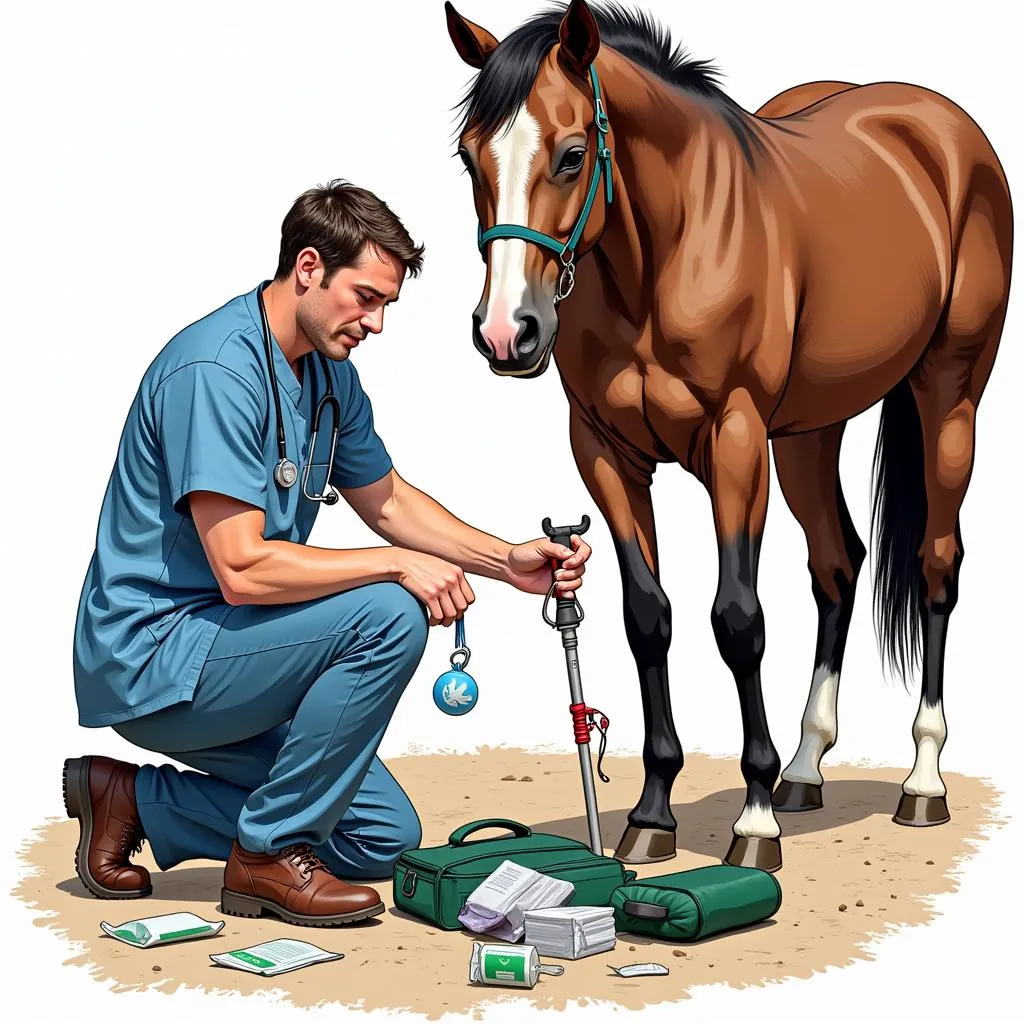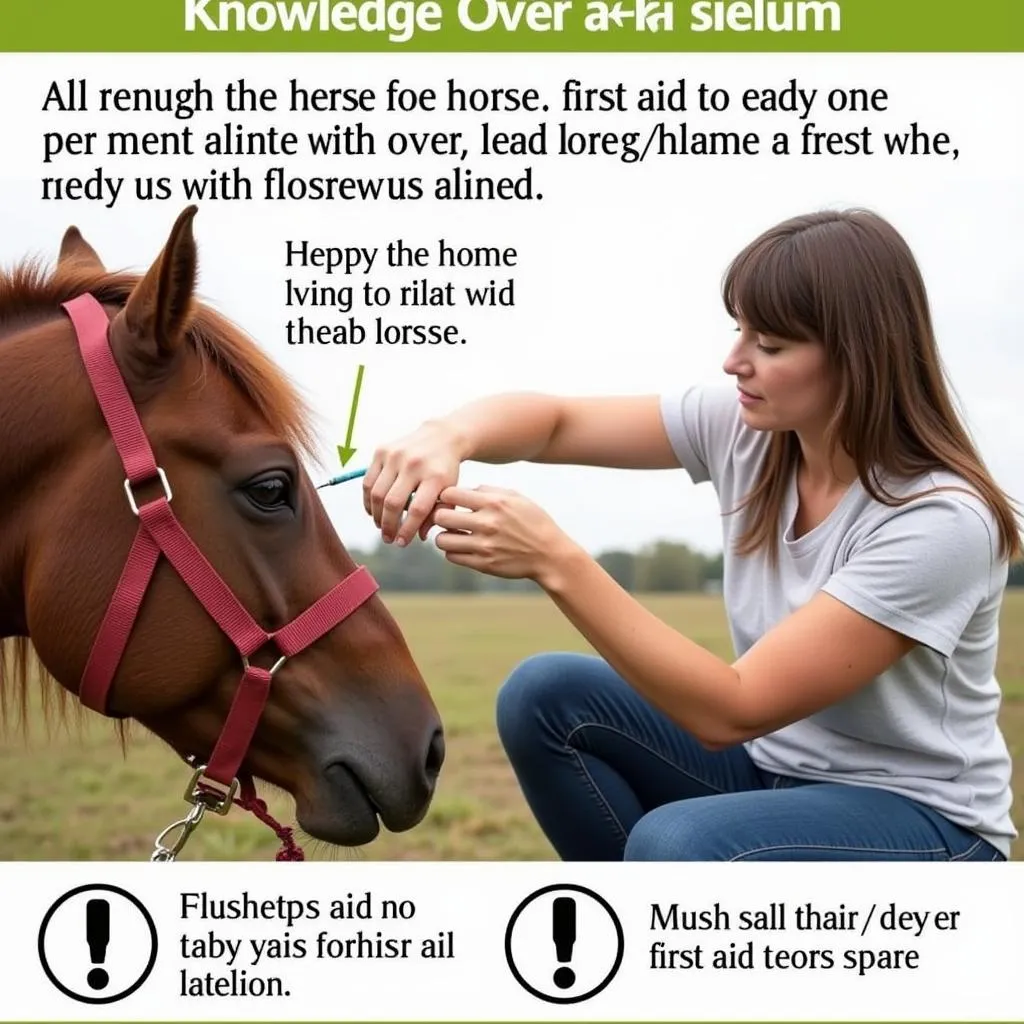As a horse owner, your equine partner’s well-being is paramount. While we strive for a safe and healthy environment, accidents and illnesses can happen. Being prepared for emergencies with a well-stocked horse first aid kit can make a world of difference in providing immediate care and potentially saving your horse’s life.
The Importance of a Horse First Aid Kit
Having a dedicated first aid kit specifically designed for horses is crucial for several reasons. First and foremost, equine anatomy and physiology differ significantly from other animals. What might be a minor injury in a dog could be life-threatening in a horse.
 Essential supplies in a horse first aid kit
Essential supplies in a horse first aid kit
Secondly, horses are prey animals, meaning they tend to mask signs of pain and injury. Early detection and prompt action are critical in equine emergencies, and a readily available first aid kit allows you to address issues before they escalate.
Essential Items for Your Horse First Aid Kit
Building a comprehensive first aid kit doesn’t need to be overwhelming. Start with these basic supplies, and gradually add more specific items as your knowledge and experience grow:
- Wound Care: Antiseptic solution (Betadine or Chlorhexidine), sterile gauze pads, cotton balls, non-stick bandages, cohesive bandages, vet wrap, duct tape, scissors, tweezers
- Medications: (Always consult with your veterinarian for appropriate dosages and administration): Phenylbutazone (bute) for pain and inflammation, Banamine (flunixin meglumine) for colic, triple antibiotic ointment
- Tools: Thermometer (rectal, digital), stethoscope, hoof pick, flashlight, leatherman or multi-tool
- Other: Latex gloves, syringes (various sizes), needles (various gauges), saline solution, towels, duct tape, permanent marker, notebook and pen
 Veterinarian examining and treating a horse's leg injury.
Veterinarian examining and treating a horse's leg injury.
Organizing and Storing Your Horse First Aid Kit
Invest in a sturdy, waterproof container to keep your horse first aid kit organized and protected from the elements. Clearly label all medications and solutions, and check their expiration dates regularly.
Consider having a smaller, portable first aid kit for trail rides and competitions. Familiarize yourself with the location of all items in your kit so you can react swiftly during an emergency.
Common Horse Emergencies and First Aid Response
Here are a few common horse emergencies and basic first aid steps:
- Lacerations: Control bleeding by applying direct pressure. Cleanse the wound with antiseptic solution and apply a sterile dressing. Consult your veterinarian immediately.
- Puncture Wounds: Do not remove any protruding objects. Cleanse the area and apply a bandage. Contact your vet immediately as these wounds are prone to infection.
- Eye Injuries: Flush the eye with saline solution. Do not attempt to remove any foreign objects embedded in the eye. Seek veterinary attention promptly.
- Colic: Colic is a general term for abdominal pain and can be life-threatening. Signs include pawing, rolling, looking at their flanks, and sweating. Remove food and water, keep the horse calm and walking, and contact your vet immediately.
 Horse owner carefully cleaning a horse's eye with saline solution.
Horse owner carefully cleaning a horse's eye with saline solution.
When to Call the Veterinarian
Always remember that first aid is not a substitute for professional veterinary care. It is crucial to contact your veterinarian immediately if your horse experiences any injury or illness.
Conclusion
A well-stocked and organized horse first aid kit is an indispensable tool for any horse owner. By understanding basic equine first aid and being prepared for emergencies, you can provide immediate care for your horse and potentially make a life-saving difference. Remember to consult with your veterinarian for guidance on specific medications and treatments, and always prioritize the safety and well-being of your equine companion.
FAQs
Q: How often should I check my horse’s first aid kit?
A: It’s best to check your kit at least every six months to ensure all medications are up to date and replace any used or expired items.
Q: Can I use human first aid supplies on my horse?
A: While some human first aid items can be used on horses, it’s crucial to consult your veterinarian for guidance. Certain human medications can be toxic to horses.
Q: Should I bandage a wound on my horse?
A: It depends on the type and severity of the wound. Always contact your veterinarian for advice on proper wound management.
Need More Help?
For immediate assistance with your horse’s health and well-being, contact Justus Horses USA at:
Phone Number: 0772127271
Email: [email protected]
Address: QGM2+WX2, Vị Trung, Vị Thuỷ, Hậu Giang, Việt Nam.
Our dedicated team is available 24/7 to provide expert advice and support. Don’t hesitate to reach out – we’re here to help you keep your horses happy and healthy.